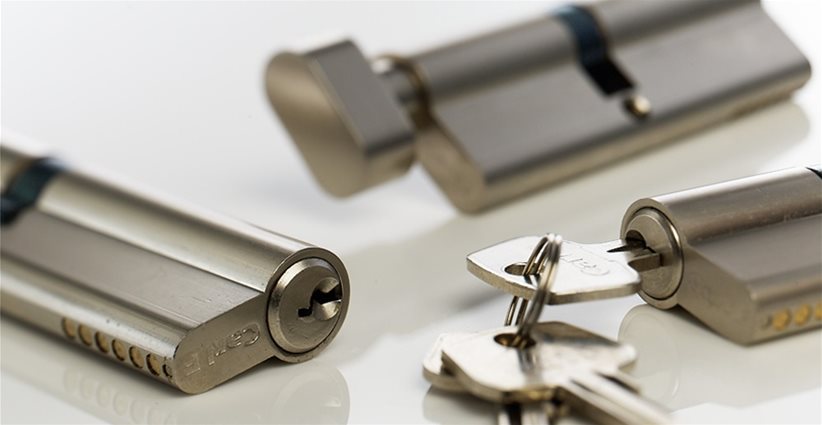
Our simple 3 step guide outlining how to select euro profile cylinders for multipoint door locks on standard residential doors.
It’s important to understand how exactly to go about choosing the cylinder that best suits your doors and project. In this article, we will cover the main things to consider for those looking to purchase euro cylinder locks for residential doors.
Our simple 3 step guide below outlines how to select euro profile cylinders for multipoint door locks on standard residential doors. For emergency exit, master key or other door types, you may require other cylinder options.
Step 1: Choosing the locking type
There are five main euro profile cylinder lock types that should be considered for residential doors: key to differ, keyed alike, keyed alike pairs, thumb turn and half cylinders.
Key to differ cylinder locks have a unique key that only operates that specific cylinder lock, ideal for situations where security is a high priority, and you don’t want anyone else gaining access. Each cylinder therefore has a different key.
Keyed alike locks where each cylinder lock uses the same key within a set of cylinders, convenient as you will only need to use 1 key to operate multiple cylinders. Commonly used for communal doors. This is different to a Master Key system where each door may have a unique key with a ‘master key’ which can still operate all of the locks.
Keyed alike pairs two cylinders are supplied with the same key, ideal for double doors or for use on the front and back door only requiring the user to carry one key to access both doors.
Thumb turn operated (or knob operation) cylinders have a turnable knob on the internal side of the door, but a key is needed to access from the outside. This is a great safety feature as it allows exit without the need to look for keys, however individual circumstances should be considered, for example, if small children are able to operate the cylinder and escape.
Half cylinder where there is only key access on one side of the cylinder, these would be used in locations where locking access is only required from one side of a door or building. For example, half cylinders are often used on garage doors.
At Carl F Groupco we provide all of these types of locking systems so that customers can choose the one that is best suited to their project.
It’s worth noting that most cylinders are supplied with at least three cut keys, and key blanks will be available for all to create additional keys as required.
Step 2: Your security requirements
The security that the cylinder provides is essential. However, many do not know the main factors that contribute to the security of a cylinder lock.
Euro profile cylinders provide basic security and all of the cylinders that Carl F Groupco supply meet at least the BS EN 1303 standard for cylinders. However, security can be added to withstand typical break in techniques including cylinder bumping, snapping, drilling, picking and plug extraction.
To simplify cylinder security grading, TS007 Kitemark offers 1 star or 3-star accreditation. To achieve full TS007 security grading, a cylinder and door handle set combined should achieve 3 stars. This is done by either fitting a 3-star cylinder and standard handle, or a 1-star cylinder and 2-star handle combination. Anti-snap is the key differentiator to achieve 3-star accreditation.
Accredited cylinders with TS007 can be identified as they will carry the BSI Kitemark.

Additionally, the length of the cylinder makes a difference to the level of security provided – the end of the cylinder should be flush with the handle (or extruding a minimum of 3mm from the backplate). This helps to prevent intruders from gripping onto the cylinder and snapping to gain access. This is why correct measuring is essential.
Another security standard for cylinders is Sold Secure, a UK certification scheme from the Master Locksmiths Association (MLA) which assess and grades security products against break in methods, they are graded as bronze, silver, gold or diamond.
Step 3: Measuring your cylinder lock
Once you have determined which type of cylinder suitable for your project, you will then need to measure the size of cylinder you require. Be sure to check by the brand, as some require measurements from the centre of the cam, while others to the edge of the cam.
Please see our video below on how to measure your cylinders:
If you have the cylinder out of the door:
Step 1: Measure the overall length from the bottom part of the cylinder.
Step 2: Measure from the centre screw hole to each end, these two measurements combined should be equal to the overall length.
If the cylinder is still fitted in the door:
Measure from the centre screw hole on the door lock to the face end of the cylinder on each side, these two measurements will be equal to the overall length.
Double Cylinders

Half Cylinders

Get A Quote
Browse our range of profile cylinder locks here and add to your quote basket today. We also offer cylinders for emergency exit and panic doors and Master Key systems. If you would like any additional information about our cylinder locks, or any of our other products, please find our enquiry form and contact details on our contact page.